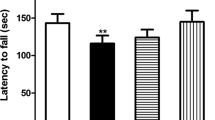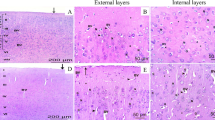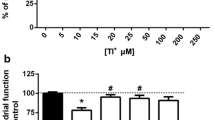Abstract
Up to now there has been no information concerning the effect of lead on the peroxidation process in brain nerve endings. We have examined whether lead acetate (in chronic and acute models of toxicity in vivo and in vitro) affected the levels of free radicals in synaptosomes obtained from rat brain. Simulateneously, we have checked the effect of peroxidation of Pb2+ on brain homogenates and microsomal fraction. Our results indicated that the lead level in synaptosomal fraction obtained from lead-treated rats was much higher than in controls. We did not observe induction of spontaneous and Fe3+-dependent peroxidation either in synaptosomes or in homogenates and brain microsomes after chronic and acute lead administration to the rats. Lead itself also did not enhance both processes when added in vitro to the control brain synaptosomes in micromolar concentrations. The lack of the lead effect on the peroxidation process in subcellular fractions of brain was rather surprising, because lead is known to be the accelerator of Fe3+-dependent peroxidation processes in liver. Additionally, livers from rats under the same toxicity conditions were examined. We have found that lead did not provoke spontaneous peroxidation in liver, but contrary to brain fractions, it drastically increased iron-dependent peroxidation in liver homogenates and microsomes. The lack of the effect of lead on inducing peroxidation processes in brain is probably the consequence of the brain having stronger protective mechanisms against its toxicity than the liver.
Similar content being viewed by others
References
Andesirk G. (1990) Effects of heavy metals on neuronal calcium channels, inFocus on Biological Effects of Heavy Metals (Foulkes E. C., ed.) CRC, Boca Raton, FL, pp. 1–18.
Andesirk G. (1993) Electrophysiology of lead intoxication: Effects on voltagesensitive ion channels.Neuro Toxicology 14 (2–3), 137–148.
Asakawa T. and Matsushita S. (1980) Coloring conditions of thiobarbituric acid test for detecting lipid hydroperoxidas.Lipids 15, 137–140.
Bligh E. G. and Dyer W. J. (1959) A rapid method of total lipid extraction and purification.Can. J. Biochem. Physiol. 37, 911–917.
Booth R. F. G. and Clark J. B. (1978) A rapid method for the preparation of relatively pure, metabolically competent synaptosomes from rat brain.Biochem. J. 176, 365–370.
Bradbury M. W. B. and Deane R. (1993) Permeability of the blood-brain barrier to lead.Neuro Toxicology 14 (2–3), 131–136.
Bucher, J. R., Tien M., and Aust S. D. (1983) The requirement for ferric in the initiation of lipid peroxidation by chelated ferrous iron.Biochem. Biophys. Res. Commun. 111, 777–784.
Dąbrowska-Bouta B., Struzyńska L., and Rafałowska U. (1994) Peroxidation in the synaptosomes under lead-toxicity conditions. 17th Annual Meeting of ENA, Vienna.
Davis, J. M., Elias R. W., and Grant L. D. (1993) Current issues in human lead exposure and regulation of lead.NeuroToxicology 14 (2–3), 15–28.
Demling R. H., Lalonde C., Ryan P., Zhu D., and Liu Y. (1988) Endotoxemia produces an increase in arterial but not venous lipid peroxides in sheep.J. Appl. Physiol. 64, 592–598.
Deutsch C., Drown C., Rafalowska U., and Silver I. A. (1981) Synaptosomes from rat brain: morphology, compartmentation and transmembrane pH and electrical gradients.J. Neurochem. 36, 2063–2071.
Floyd R. A. (1983) Direct demonstration that ferrous iron complexes of di- and tri-phosphate nucleotides catalyze hydroxyl free radical formation from hydrogen peroxide.Arch. Biochem. Biophys. 225, 263–270.
Floyd R. A. and Lewis, C. A. (1983) Hydroxyl free radical formation from hydrogen peroxide by ferrous iron-nucleotide complexes.Biochemistry 22, 2645–2649.
Floyd R. A., Zaleska M. M., and Herman H. J. (1984) Possible involvement of iron and oxygen free radicals in aspects of aging in brain, inFree Radicals in Molecular Biology, Aging and Disease (Armstrong D., Sohal R. S., and Sulter R. G., and Slater F. F. (eds), Raven, New York, pp. 143–161.
Folch J., Lees M., and Sloane Stanley G. H. (1957) A simple method for the isolation and purification of total lipides from animal tissues.J. Biol. Chem. 226, 497–509.
Goering P. L. (1993) Lead-protein interactions as a basis for lead toxicity.Neuro-Toxicology 14, 45–60.
Goldstein G. W., Asbury A. K., and Diamond I. (1974) Pathogenesis of lead encephalopathy: Uptake of lead and reaction of brain capillaries.Arch. Neurol. 31, 382–389.
Gradjean Ph. (1993) International perspectives of lead exposure and lead toxictity.NeurToxicology 14, 9–14.
Hochstein P. and Ernster L. (1963) ADP-activated lipid peroxidation coupled to the TPN oxidase system of microsomes.Biochem. Biophys. Res. Commun. 12, 388–394.
Holtzman D., DeVries C., Nguyen H., Olson T., and Bensch K. (1984) Maturation of resistance to lead encephalopathy: Cellular and subcellular mechanisms.NeuroToxicology 5, 97–124.
Hypponen S., Kohila T., and Tahti H. (1993) The effects of cadmium, lead and aluminium on neural cell membrane adenosine triphosphatase activity.Neurosci. Res. Commun. 12, 77–84.
Jablonska L., Walski M., and Rafalowska U. (1994) Lead as an inductor of some morphological and functional changes in synaptosomes from rat brain.Cell. Mol. Neurobiol. 14, 701–709.
Legare M. E., Barhoumi R., Burghardt R. C., and Tiffany-Castiglioni E. (1993) Low level lead exposure in cultured astroglia: Identification of cellular targets with fluorescent probes.NeuroToxicology 14, 267–272.
Lowry O. H., Rosebrough N. J., Farr A. L., and Randall R. J. (1951) Protein measurements with Folin phenol reagent.J. Biol. Chem. 193, 265–275.
Needleman H. L. (1980)Low Level Lead Exposure. The Clinical Implications of Current Research. Raven, New York.
Oortgiesen M., Leinolers T., Van Kleef R. G. O. M., and Vijverberg H. P. M. (1993) Differential neurotoxicological effects of lead on voltage-dependent and receptor-operated ion channels.NeuroToxicology 14, 87–96.
Quinlan S. J., Halliwell B., Moorhouse Ch. P., and Gutteridge J. M. C. (1988) Action of lead II and aluminium (III) ions on iron-stimulated lipid peroxidation in liposomes, erythrocytes and rat liver microsomal fractions.Biochim. Biophys. Acta 962, 196–200.
Rafalowska U. and Walajtys-Rode E. (1991) Peroxidation-induced changes of histamine metabolism and transport of its precursor histidine in rat brain synaptosomes.Free Radical Biol. Med. 10, 23–28.
Rafalowska U., Erecinska M., and Wilson D. W. (1980) Energy metabolism in rat brain synaptosomes from nembutal-anesthetized and nonanesthetized animals.J. Neurochem. 34, 1380–1386.
Rafalowska U., Gordon-Majszak W., and Dabrowiecki Z. (1986) Consequence of exposure of rats to hyperoxygenation for actomyosin-like protein from brain synaptosomes.Neurochem. Pathol. 5, 107–115.
Rafalowska U., Guang-Jun Liu, and Floyd R. A. (1989) Peroxidation-induced changes in synaptosomal transport of dopamine and aminobutyric acid.Free Radical Biol. Med. 6, 485–492.
Ribarov S. R. and Benov L. C. (1981) Relationship between the hemolytic action of heavy metals and lipid peroxidation.Biochim. Biophys. Acta 640, 721–726.
Ribarov S. R. and Bochev P. G. (1982) Lead-hemoglobin interaction as a possible source of reactive oxygen species—a chemiluminescent study.Arch. Biochem. Biophys. 213, 288–292.
Ribarov S. R., Benov L. C., and Bencher I. C. (1980) Hemolytic action of lead in experiments in vitro.Pharmacol. Toxicol. 43, 620–622.
Romero F. J., Segura-Aguilar J., Monsolve E., Hermenegildo C., Nies E., Puertas F. J., and Rama J. (1990) Antioxidant and glutathione-related enzymatic activities in rat sciatic nerve.Neurotoxicol. Teratol. 12, 603–605.
Shafiq-UR-Rehman (1984) Lead-induced regional lipid peroxidation in brain.Toxicol. Lett. 21, 333–337.
Silbergeld E. K., Fales, J. T., and Goldberg A. M. (1974a) The effects of inorganic lead on the neuromuscular function.Neuropharmacology 13, 795–801.
Silbergeld E. K., Fales J. T., and Goldberg A. M. (1974b) Evidence for a junctional effect of lead on neuromuscular function.Nature (Lond.)247, 49–50.
Simons T. J. B. (1993) Lead-calcium interaction in cellular lead toxicity.NeuroToxicology 14, 77–86.
Skoczyńska A., Smolik R., and Jeleń M. (1993) Lipid abnormalities in rats given small doses of lead.Arch. Toxicol. 67, 200–204.
Strużyńska L. and Rafalowska U. (1994) The effect of lead on dopamine, GABA and histidine spontaneous and KCl-dependent release from rat brain synaptosomes.Acta Neurobiol. Exp. 54, 201–207.
Strużyńska L., Dabrowska-Bouta B., LenartJ., Zborowski J., and Rafalowska U. (1994) Some metabolic effects in rat brain synaptosomes after exposure to lead in vivo and in vitro.Bull. Acad. Pol. Sci. 42, 55–62.
Tiffany-Castiglioni E. (1993) Cell culture models for lead toxicity in neuronal and glial cells.NeuroToxicology 14, 513–536.
Wilbur K. M., Bernheim F., and Shapiro O. W. (1949) The thiobarbituric acid reagent as a test for the oxidation of unsaturated fatty acids by various agents.Arch. Biochem. Biophys. 24, 305–313.
Wills E. D. (1965) Mechanisms of lipid peroxide formation in tissues: Role of metals and hematin proteins in the catalysis of the oxidation of unsaturated fatty acids.Biochim. Biophys. Acta 98, 238–251.
Zaleska M. M. and Floyd R. A. (1985) Regional lipid peroxidation in rat brain in vitro. Possible role of endogenous iron.Neurochem. Res. 10, 397–410.
Author information
Authors and Affiliations
Rights and permissions
About this article
Cite this article
Dąbrowska-Bouta, B., Struzyńska, L. & Rafałowska, U. Does lead provoke the peroxidation process in rat brain synaptosomes?. Molecular and Chemical Neuropathology 29, 127–139 (1996). https://doi.org/10.1007/BF02814997
Received:
Revised:
Accepted:
Issue Date:
DOI: https://doi.org/10.1007/BF02814997




